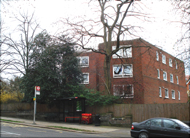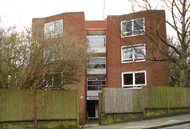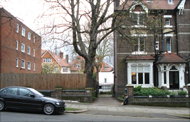Marie
Curie Hospital
for Cancer and Allied Diseases
for Cancer and Allied Diseases
66 Fitzjohn's Avenue, NW3
Medical
dates:
Medical
character:
Specialist
Founded by medical women for the
"radiological treatment of women suffering from cancer and allied
diseases", the Marie Curie Hospital opened in 1929. A public
appeal had raised the necessary funds to purchase No. 2 Fitzjohn's
Avenue. The building was converted into a
30-bed hospital which was to be staffed entirely by women. Madame
Marie
Curie
(1867-1934), the scientist who discovered polonium and radium in 1898,
was most interested in the project and allowed her name to be given to
the hospital.
The Hospital was officially opened in 1930 by the then Prime Minister, Stanley Baldwin, and the ceremony was attended by both the Polish and the French Ambassadors, representing the native and adopted countries of Marie Curie.
Increased demand for treatment made it necessary to open an Out-Patients Department (in the coal cellar) the same year, so that previously treated patients could be followed up at regular intervals. Radium insertion treatments were chiefly for gynaecological cancers, but radiation therapy for carcinoma of the breast had to be carried out at other hospitals as the Marie Curie Hospital lacked the necessary equipment.
The demand for further bed accommodation and the need for its own X-ray equipment led to the purchase of the adjoining building, No. 4 Fitzjohn's Avenue, in 1933. The extension was opened in 1934 by the Duchess of York (later Queen Elizabeth the Queen Mother). On 19th March 1937 a new building for research laboratories - the Helen Chambers Laboratories - and a Nurses' Home were opened by Queen Mary, patron of the Hospital. By then the Hospital had 39 beds (including 9 for private patients), and facilities for radium and X-ray therapy, hostel accommodation for out-of-town patients and modern pathology and research laboratories. In 1938 it was renamed the Marie Curie Hospital for Cancer and Allied Diseases.
At the outbreak of WW2 the radium was removed and safely stored in the vaults of the Middlesex Hospital. The patients were transferred to country hospitals and the Marie Curie Hospital was taken over by the local council. However, after only six weeks, the X-ray therapy unit with 11 beds was reopened and a limited number of patients treated with radon (a radioactive gas). By March 1940 arrangements had been made to store the radium on-site.
In 1944 the buildings, except for the new wing and the shelter, were totally destroyed by a high explosive bomb, fortunately with no casualties (the mainly elderly patients had been taken by
the staff to the shelter). The radium, stored in steel cylinders, was buried beneath the demolished building and not recovered for almost three weeks. In-patients were transferred to the nearby North Western Hospital, where temporary arrangements were made available for radium insertions. Patients receiving X-ray therapy were sent to Mount Vernon Hospital in Northwood or to the Middlesex Hospital.
Until the opening of the new Westminster Hospital in 1938, its patients had received radiotherapy at its annex at 66 Fitzjohn's Avenue. This building, previously Havelock Hall, a Baptist Training College, on the corner of Fitzjohn's Avenue and Akenside Road had been unoccupied during the war and was an obvious choice for the temporary relocation of the Marie Curie Hospital. Following considerable repairs and improvement, the 50-bedded Hospital was officially opened by Queen Mary in 1946.
Appeals were launched for funds to build a new 100-bedded hospital on the site of the previous one and, by 1948, at the beginning of the NHS, over £100,000 had been raised. However, even though architect's plans had been drawn up, the project failed and the Hospital continued in its temporary premises.
Even though the Marie Curie Hospital had acquired a 10-gramme teleradium (radium beam) unit, modern developments in cancer treatments, such as cobalt beam therapy and megavoltage, rendered its facilities inadequate in comparison with other hospitals. In 1965 it was decided to move the Hospital in its entirety to a ward at Mount Vernon Hospital, where the equipment of a modern radiotherapy department would be available.
The Marie Curie Hospital closed in 1967.
The Hospital buildings were demolished in 1969. The site has been redeveloped and now contains an apartment block fronting Akenside Road.
The Hospital was officially opened in 1930 by the then Prime Minister, Stanley Baldwin, and the ceremony was attended by both the Polish and the French Ambassadors, representing the native and adopted countries of Marie Curie.
Increased demand for treatment made it necessary to open an Out-Patients Department (in the coal cellar) the same year, so that previously treated patients could be followed up at regular intervals. Radium insertion treatments were chiefly for gynaecological cancers, but radiation therapy for carcinoma of the breast had to be carried out at other hospitals as the Marie Curie Hospital lacked the necessary equipment.
The demand for further bed accommodation and the need for its own X-ray equipment led to the purchase of the adjoining building, No. 4 Fitzjohn's Avenue, in 1933. The extension was opened in 1934 by the Duchess of York (later Queen Elizabeth the Queen Mother). On 19th March 1937 a new building for research laboratories - the Helen Chambers Laboratories - and a Nurses' Home were opened by Queen Mary, patron of the Hospital. By then the Hospital had 39 beds (including 9 for private patients), and facilities for radium and X-ray therapy, hostel accommodation for out-of-town patients and modern pathology and research laboratories. In 1938 it was renamed the Marie Curie Hospital for Cancer and Allied Diseases.
At the outbreak of WW2 the radium was removed and safely stored in the vaults of the Middlesex Hospital. The patients were transferred to country hospitals and the Marie Curie Hospital was taken over by the local council. However, after only six weeks, the X-ray therapy unit with 11 beds was reopened and a limited number of patients treated with radon (a radioactive gas). By March 1940 arrangements had been made to store the radium on-site.
In 1944 the buildings, except for the new wing and the shelter, were totally destroyed by a high explosive bomb, fortunately with no casualties (the mainly elderly patients had been taken by
the staff to the shelter). The radium, stored in steel cylinders, was buried beneath the demolished building and not recovered for almost three weeks. In-patients were transferred to the nearby North Western Hospital, where temporary arrangements were made available for radium insertions. Patients receiving X-ray therapy were sent to Mount Vernon Hospital in Northwood or to the Middlesex Hospital.
Until the opening of the new Westminster Hospital in 1938, its patients had received radiotherapy at its annex at 66 Fitzjohn's Avenue. This building, previously Havelock Hall, a Baptist Training College, on the corner of Fitzjohn's Avenue and Akenside Road had been unoccupied during the war and was an obvious choice for the temporary relocation of the Marie Curie Hospital. Following considerable repairs and improvement, the 50-bedded Hospital was officially opened by Queen Mary in 1946.
Appeals were launched for funds to build a new 100-bedded hospital on the site of the previous one and, by 1948, at the beginning of the NHS, over £100,000 had been raised. However, even though architect's plans had been drawn up, the project failed and the Hospital continued in its temporary premises.
Even though the Marie Curie Hospital had acquired a 10-gramme teleradium (radium beam) unit, modern developments in cancer treatments, such as cobalt beam therapy and megavoltage, rendered its facilities inadequate in comparison with other hospitals. In 1965 it was decided to move the Hospital in its entirety to a ward at Mount Vernon Hospital, where the equipment of a modern radiotherapy department would be available.
The Marie Curie Hospital closed in 1967.
The Hospital buildings were demolished in 1969. The site has been redeveloped and now contains an apartment block fronting Akenside Road.

The site of 66 Fitzjohn's Avenue, now the back garden of the apartment block on Akenside Road


No. 64 Fitzjohn's Avenue is shown on the right
The front elevation of the apartment block on Akenside Road
(Author unstated) 1929 Outside the gates. British Journal of Nursing (July), 191.
(Author unstated) 1930 The Marie Curie Hospital. British Journal of Nursing (September), 242.
(Author unstated) 1937 The Hospital World. British Journal of Nursing (April), 103.
(Author unstated) 1939 The Hospital World. British Journal of Nursing (April), 106.
(Author unstated) 1946 Nursing echoes. British Journal of Nursing (October), 111.
(Author unstated) 1977 Hampstead at War. London, Camden History Press.
Dickson RJ 1968 The Marie Curie Hospital 1925-68. British Medical Journal 4 (5628), 444-446.
Return to home page